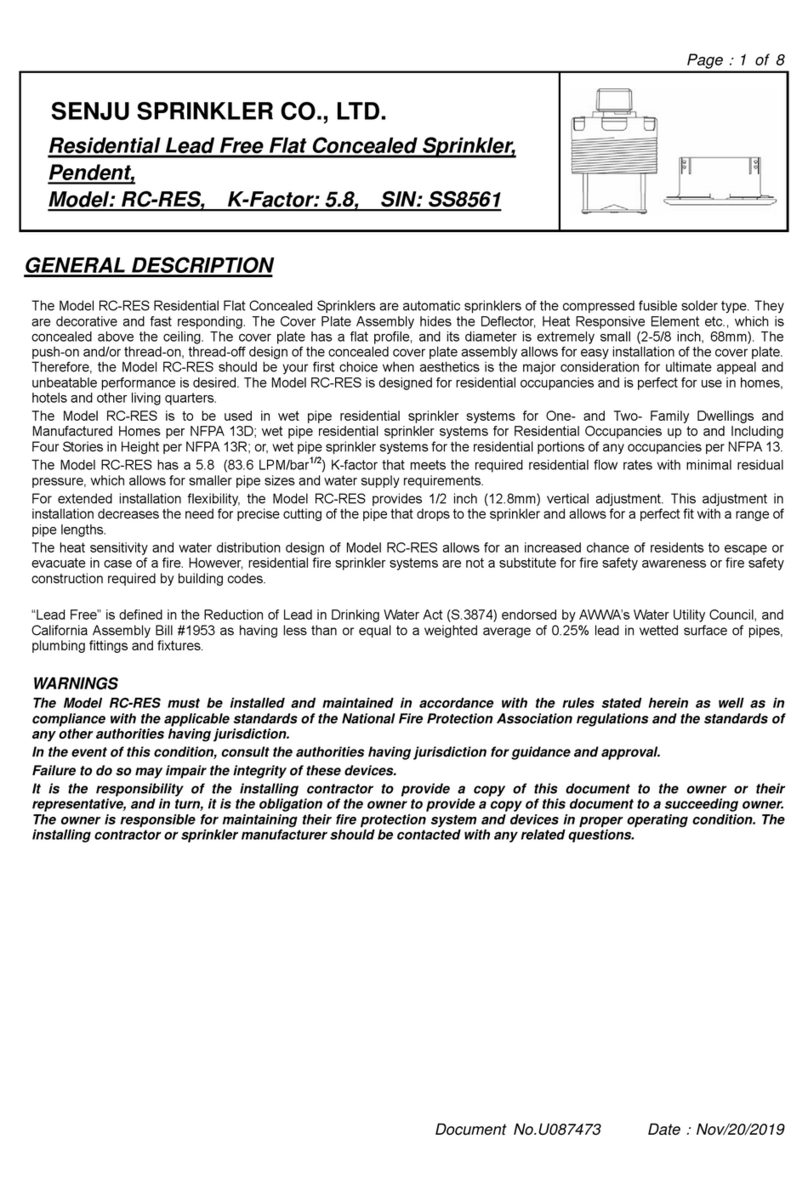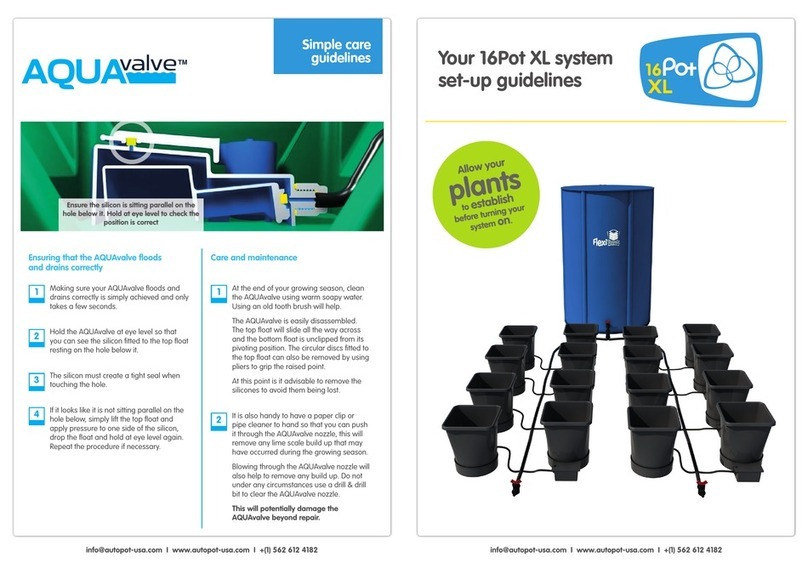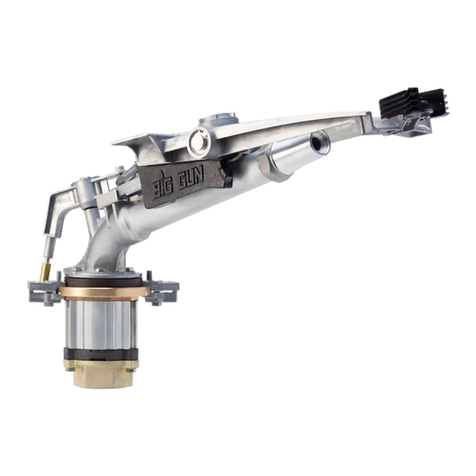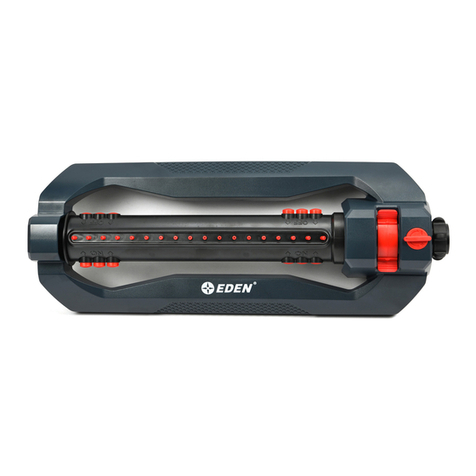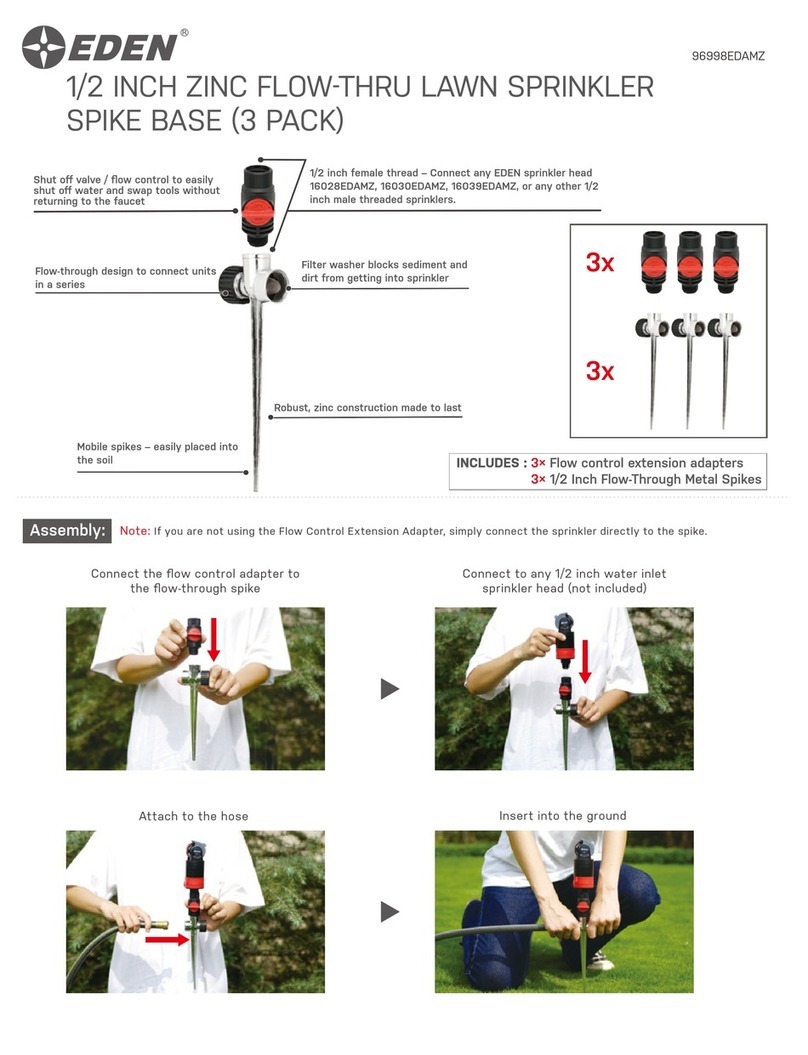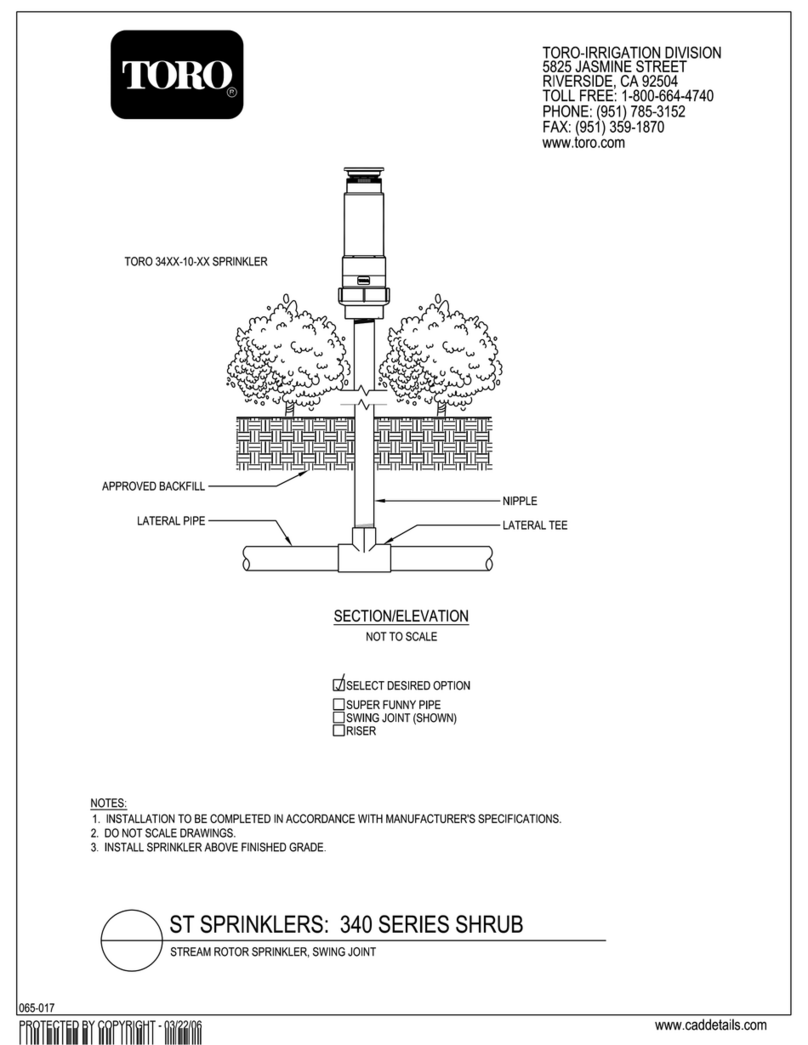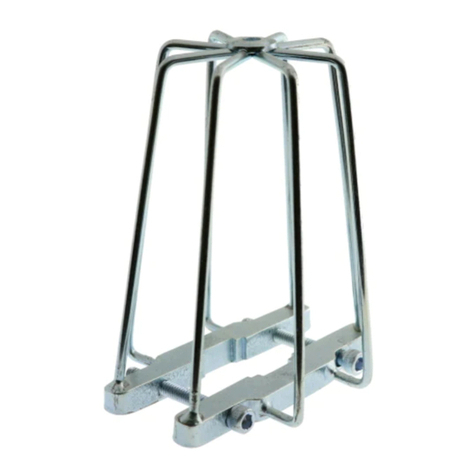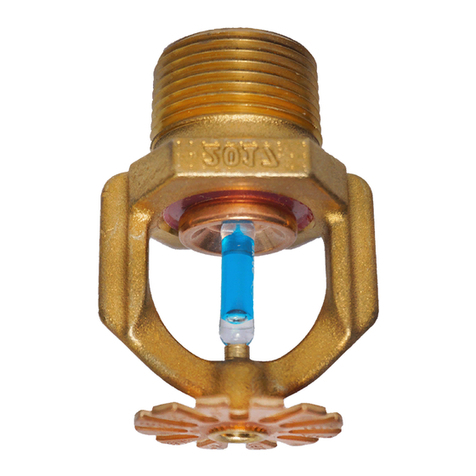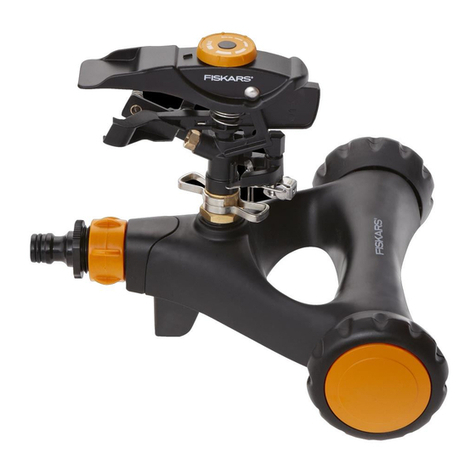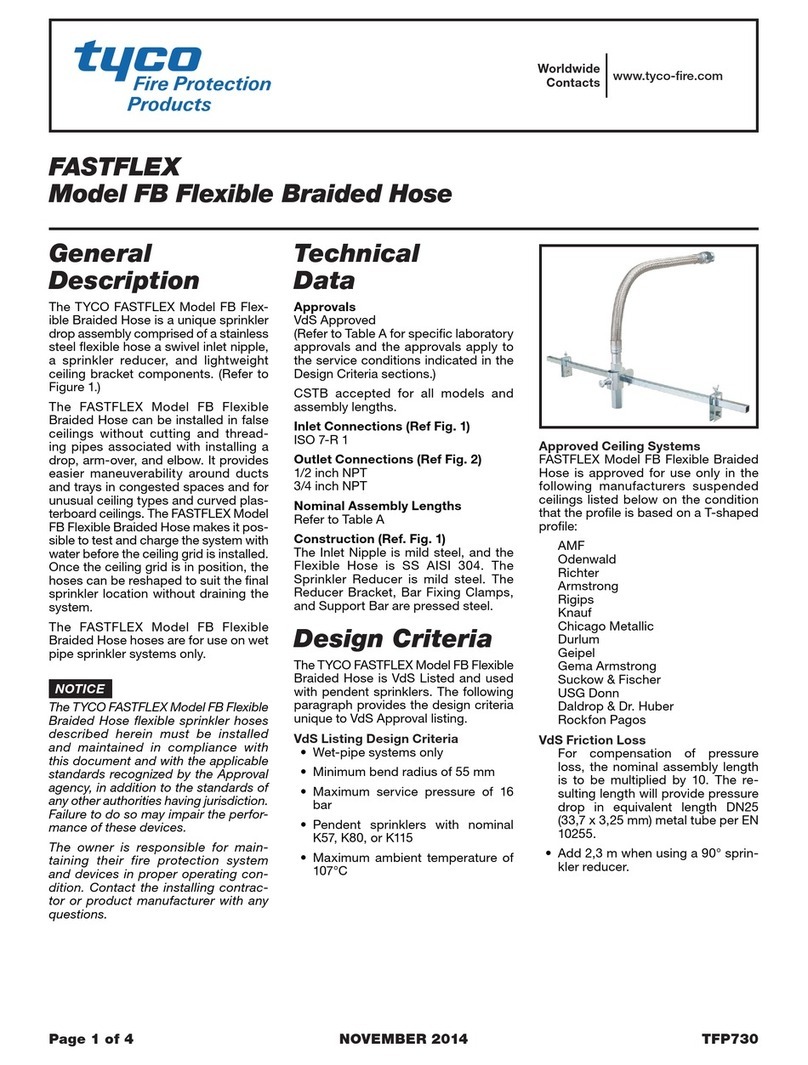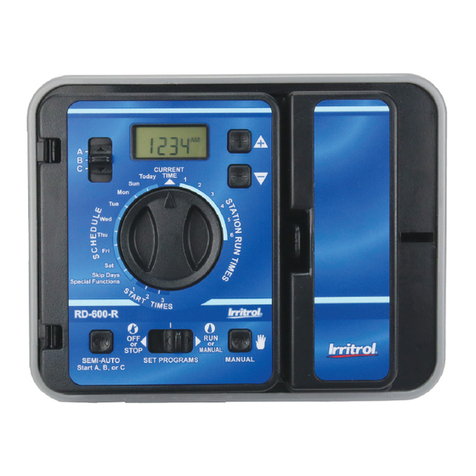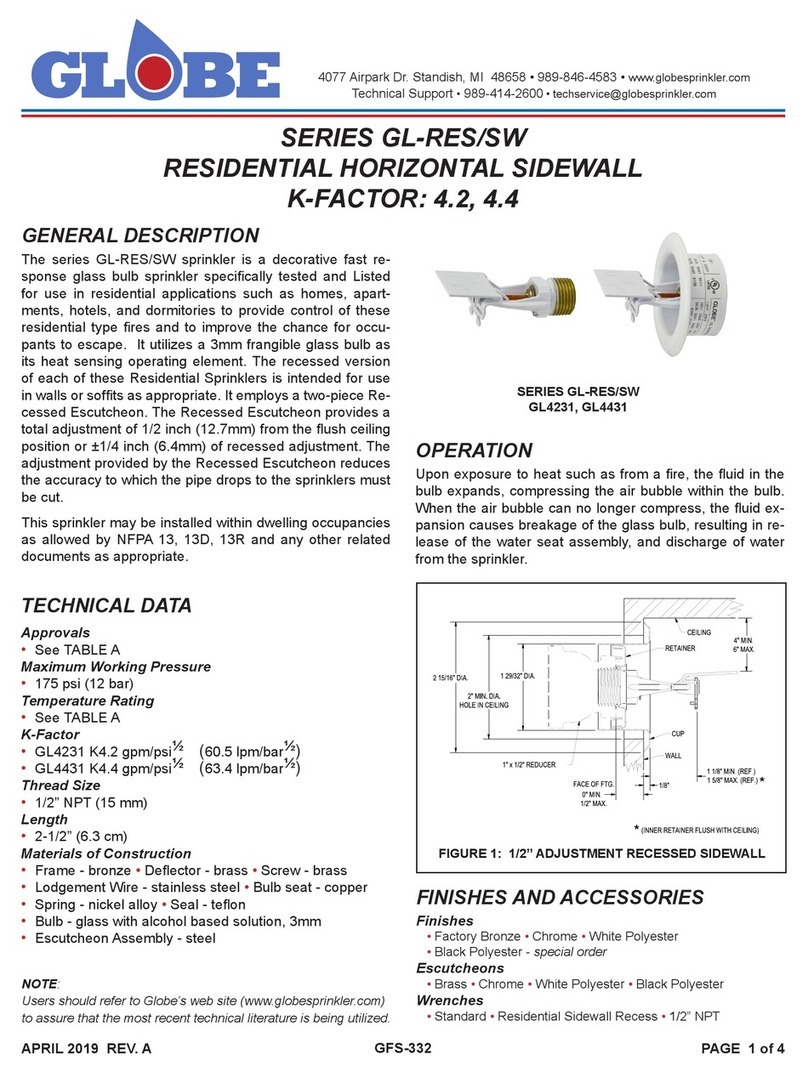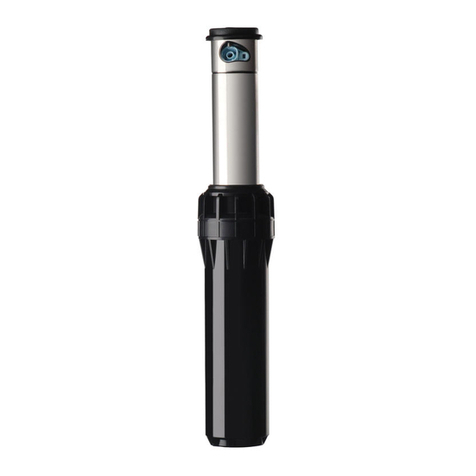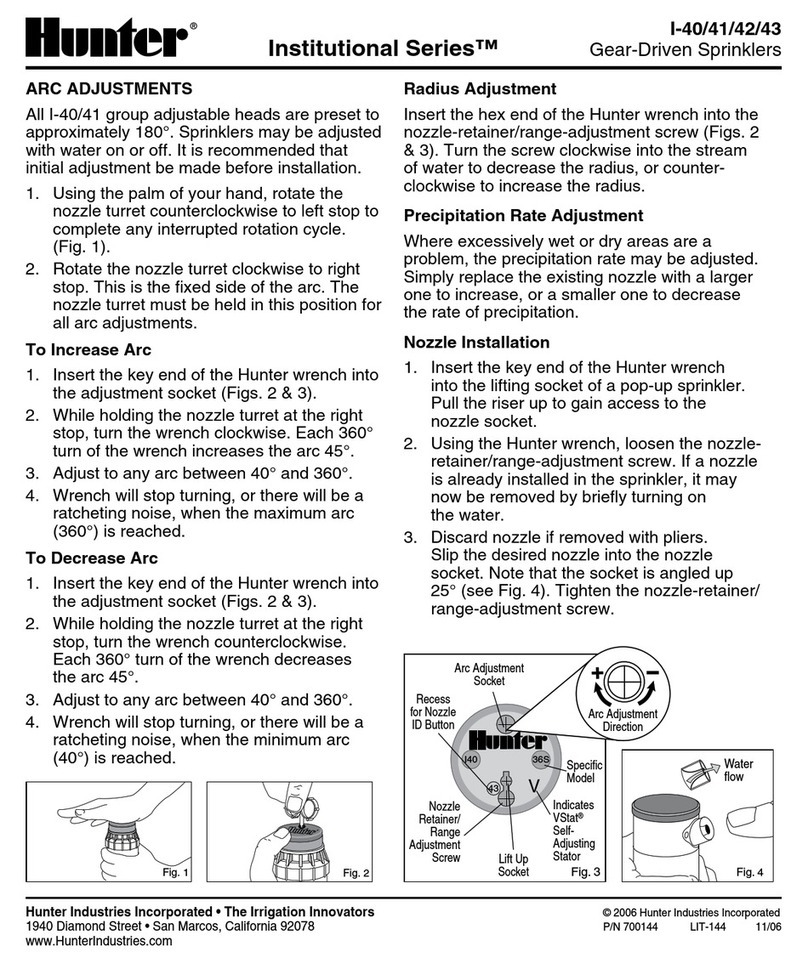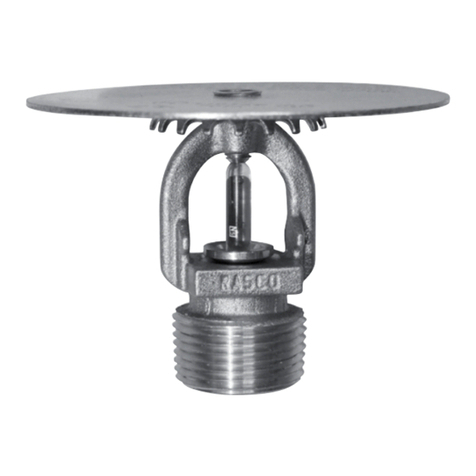Senju Sprinkler HF-RES User manual

Page:1 of 5
Document No.U028704 Date:Jan/11/2019
Residential Flush Horizontal Side-Wall Sprinkler
Model HF-RES
,
K=4.2
(
SIN / SS4423
)
(PTFE gasketed orifice seal design)
General Description
The Model HF-RES Residential Flush Horizontal Side-Wall Sprinklers are
automatic sprinklers of the compressed fusible solder type. They are
decorative, low profile, flush mount sprinklers. The Frame and Cover of the
sprinkler hide the Deflector and Valve Cap assemblies. (Reference Figure
1)
The Model HF-RES is designed for use in residential occupancies such as
homes, apartments, dormitories, and hotels. When aesthetics is the major
consideration, the Model HF-RES should be your first choice.
They are to be used in wet pipe residential sprinkler systems for one- and
two-family dwellings and manufactured homes per NFPA 13D; wet pipe
residential sprinkler systems for residential occupancies up to and including
four stories in height per NFPA 13R; or, wet pipe sprinkler systems for the
residential portions of any occupancy per NFPA 13.
The Model HF-RES has a 4.2 (60.5 LPM / bar1/2) K-factor which provides
very low design flow rates at reduced residual pressures, enabling smaller
pipe sizes and water supply requirements.
The flush design of the Model HF-RES features a separable escutcheon
providing 3/16 inch (4.7 ㎜) of total adjustment.
This adjustment reduces the accuracy to which the fixed pipe drops to the
sprinklers must be cut to help assure a perfect fit installation.
The Model HF-RES has been designed with heat sensitivity and water
distribution characteristics proven to help in the control of residential fires to
improve the chance for occupants to escape or be evacuated. However,
residential fire sprinkler systems are not a substitute for intelligent fire safety
awareness or fire safety construction required by building codes.
WARNINGS
The Model HF-RES Residential Flush Horizontal Side-Wall Sprinklers
described herein must be installed and maintained in compliance with this
document, as well as with the applicable standards of the National Fire
Protection Association, in addition to the standards of any authorities having
jurisdiction. Failure to do so may impair the integrity of these devices.
Because of the above cited stipulations and the varied nature of residential
type architecture, there will be some compartment designs which cannot be
fully sprinklered in accordance with the recommendations of NFPA 13, 13D,
or 13R, In the event of this condition, consult the authorities having
jurisdiction for guidance and approval.
It is the responsibility of the installing contractor to provide a copy of this
document to the owner or his representative, and in turn, it is the obligation
of the owner to provide a copy of this document to asucceeding owner.
The owner is responsible for maintaining their fire protection system and
devices in proper operating condition. The installing contractor or sprinkler
manufacturer should be contacted relative to any questions.
FIGURE 1
MODEL HF-RES K=4.2 RESIDENTIAL FLUSH HORIZONTAL
SIDE-WALLSPRINKLER
Technical Data
Approvals:
ULand ULC Listed.
Sprinkler Identification Number:
SIN SS4423
Maximum Working Pressure:
175 psi (12.1 bar)
Discharge Coefficient:
K = 4.2 GPM / psi1/2 (60.5 LPM / bar1/2)
Temperature Rating:
162 ℉/ 72 ℃
HorizontalAdjustment:
3/16 inch (4.7 ㎜)
Finishes:
Sprinkler and Escutcheon:
White Painted, Black Painted, Dark Brown Painted,
Chrome Plated.
Physical Characteristics:
Dezincification resistant copper alloy body and PTFE gasketed orifice
seal design.
Yearof Manufacture
Temperature Rating (162 F)
Listing Mark
Country Origin
I.D Number (SIN)
Marking
Four Wrench Slots
5-Cover (Copper)
7-Fusible Metal
2-Frame (Bronze)
1-Body (Copper Alloy)
6
6-Heat Collector (Copper)
8-Sub Deflector (Copper Alloy)
4-Gasket (PTFE)
3-Deflector (Copper Alloy)
COMPONENTS (MATERIALS) :
74
NPT 1/2
2- 7/16"
2
138
5
9-Valve Cap (Copper Alloy)
9

Page:2 of 5
Document No.U028704 Date:Jan/11/2019
Operation
The Sprinkler assembly contains a small fusible solder element. When
exposed to sufficient heat from a fire, the solder melts and enables the
internal components of the sprinkler to be released. At this point the
sprinkler activates with the deflector moving into its operated position
(Reference Figure 2), permitting water to flow.
FIGURE 2
Design Criteria
The Model HF-RES Residential Flush Horizontal Side-Wall Sprinklers must
only be installed and utilized in accordance with the following described
criteria, which are provided by the manufacturer.
TABLE A
NFPA 13DAND NFPA 13R HYDRAULIC DESIGN CRITERIA
for Model SS4423
Ordinary Temperature Rating:162℉(72℃)
Maximum
Coverage
Area(a)
Ft.×Ft.
(m×m)
Flow
GPM
(L/min)
Pressure
PSI
(bar)
Top of
Sub
Deflector
to
Ceiling
Installation
Type
Minimum
Spacing
Ft.
(m)
12×12
(3.7×3.7) 13
(49.2) 9.6
(0.66)
14×14
(4.3×4.3) 16
(60.6) 14.5
(1.00)
16×16
(4.9×4.9) 20
(75.7) 22.7
(1.56)
4 to 6
Inches Flush 8
(2.4)
(a) For coverage area dimensions less than or between those indicated, it is
necessary to use the minimum required flow for the next highest coverage area
for which hydraulic design criteria are stated.
(b) Requirement is based on minimum flow in GPM from each sprinkler. The
associated residual pressures are calculated using the nominal K-factor. Refer to
Hydraulic Design Criteria Section for details.
(c) For systems with ceiling types smooth flat horizontal, or beamed, or sloped, in
accordance with the 2013 Edition of NFPA13D, 13R or 13 as applicable.
NOTES
Residential Fire Sprinkler Systems should only be designed and installed by
those component and completely familiar with automatic sprinkler system
design, installation procedures, and techniques.
Several criteria may apply to the installation and usage of each sprinkler.
Consequently, it is recommended that the sprinkler system designer review
and develop a working understanding of the complete list of criteria prior to
initiating the design of the sprinkler system.
Questions concerning sprinkler installation and usage criteria, which are not
coverage by the following instructions, should be submitted to Contact
Company. Include sketches and technical details as appropriate.
In some instances, the requirements of this document may concern
specifications which are more stringent and which take precedence over
those specified in NFPA 13, NFPA 13D, NFPA 13R, or by the authority having
jurisdiction.
The spray from the sprinkler is distributed outward and downward from the
sprinkler deflector in a semicircle. Consequently, the sprinklers must be
located such that there will not be any blind spaces shielded from spray by
partitions, room dividers, overhangs or other parts of the dwelling structure.
The number of sprinklers within each compartment (as defined by NFPA 13,
13D, or 13R) must be kept as few as possible. Do NOT use more sprinklers
than necessary to cover a particular space.
Use only the escutcheon provided with the Model
HF-RES
.
The sprinkler must be secured in position by firmly fastening the sprinkler
system piping to the structure. If the sprinkler is not properly secured in
position, reaction forces resulting from sprinkler operation could alter its
orientation and its water distribution pattern.
The sprinkler escutcheon cannot be used to hold the sprinkler in position.
Obstruction to Water Distribution
Locations of sprinklers are to be in accordance with the
obstruction rues of NFPA 13 for Residential Sprinklers.
Precautionary Warnings for Corrosive Environments
Model HF-RES should not be installed where they may be subjected to a
corrosive environment including the following:
1
)
Chlorine ion and Chloride environment.
Stress corrosion cracking may be caused by exposure to environments
with Chlorine ion and Chloride. Exposure to this environment may result
in sprinklers operating under non-fire conditions or not operating when
exposed to an actual fire.
2
)
Sprinkler system piping with Copper.
Sprinkler systems should be constructed in compliance with the
applicable standards and the requirements for the copper piping when
copper piping is used in the sprinkler system. (Reference standards
NFPA 13, ASTM B813, ASTM B828, and CDA (Copper Development
Association) – Solder Joint)
All residual flux must be removed from the interior and exterior of copper
piping by thoroughly flushing before installation of the Sprinkler Heads.
Otherwise, residues of flux may cause corrosion and leakage in the
sprinkler system.
General Service Conditions
The Model HF-RES must only be utilized in wet pipe sprinkler systems.
Hydraulic Design Criteria
The minimum required sprinkler flow rates for systems designed to
NFPA 13D or NFPA 13R are given in Table A as a function of
temperature rating and the maximum allowable coverage areas. The
sprinkler flow rate is the minimum required discharge from the most
hydraulically demanding sprinkler from each of the total number of
“design sprinklers” as specified in NFPA13D or NFPA 13R.
Normal Condition
Operation
W
ater Discharge

Page:3 of 5
Document No.U028704 Date:Jan/11/2019
For systems designed to NFPA 13, the number of design sprinklers is to
be the four most hydraulically demanding sprinklers. The minimum
required discharge from each of the four sprinklers is to be the greater of
the followings:
・ The flow rates given in Table Afor NFPA 13D and 13R as a function of
temperature rating and maximum allowable coverage area.
・ A minimum discharge 0.1gpm/sq.ft. [4.07(L/min)/sq.m] over the
“design area” comprised of the four most hydraulically demanding
sprinklers for the actual coverage areas being protected by the four
sprinklers.
Operational Sensitivity Criteria
For proper operational sensitivity, the model HF-RES must be installed
under smooth, flat, horizontal ceilings as outlined in the applicable
installation standard recognized by the approval agency (e.g. UL
recognizes NFPA 13, 13Dand 13R)
The distance from the Top of the sub-deflector to the ceiling has to be
within 4-6 inches.
The Model HF-RES must NOT be used above or below open-gridded
type suspended ceilings; beneath soffits or beams exceeding 3 inches in
height or joists, or ducts having a height of more than 3 inches located
within the sprinkler coverage areas.
Beams having a height of more than 3 inches may be located with their
centerlines along the boundaries separating adjacent sprinkler coverage
areas.
Sprinkler Spacing Criteria
The minimum spacing between sprinklers is 8 feet. The maximum
spacing between sprinklers cannot exceed the length of the coverage
are being hydraulically calculated.
Heat Source Criteria
Refer to NFPA 13D or NFPA 13R for the requirements relating to
preventing the possible release of a Model HF-RES heat responsive
element, due to exposure to heat sources other than an actual fire.
Installation
The Model HF-RES must be installed in accordance with the following
instructions:
NOTES
Do not use sprinklers which have been subjected to potential mechanical
damage. Do not use sprinklers which show deformation or cracking in either
the sprinkler or protection cap.
The Protective Cap must remain on the sprinkler during installation and until
the ceiling installation is completed. The Protective Cap must be removed to
place the sprinkler in service.
A leak tight 1/2-inch NPT sprinkler joint should be obtained with a torque of
7 to 14 ft.lbs. (9.5 to 19.0 Nm). A maximum of 21 ft.lbs. (28.5 Nm) of torque is
to be used to install sprinklers. Higher levels of torque may distort the
sprinkler inlet with consequent leakage or impairment of the sprinkler.
Do not attempt to compensate for insufficient adjustment in an Escutcheon
Plate by under- or over-tightening the sprinkler. Readjust the position of the
sprinkler fitting to suit.
Installing procedure
Step 1.
The sprinkler must be installed only in the sidewall position with their
centerline of waterway perpendicular to the back wall and parallel to the
ceiling. The word “TOP” on the sub-deflector has to face towards the
ceiling with the front edge of the sub-deflector parallel to the ceiling.
Step 2.
Install the sprinkler fitting so that the distance from the face of the fitting
to the mounting surface will be nominally 53/64 inch (21.0mm) as shown
in Figure 3.
FIGURE 3
Step 3.
With pipe thread sealant applied to the pipe threads, hand tightens the
Sprinkler into the sprinkler fitting.
Step 4.
Wrench tighten the Sprinkler using only the Sprinkler Socket or Wrench
& Socket Combination (Ref. Figure 4). Put the Sprinkler Socket over the
sprinkler without the sub-deflector hit till the socket touches the body of
the sprinkler. Turn the socket till the wrench recess of the Socket can be
applied to the sprinkler wrenching area (Ref. Figure 4).
Special care must be exercised to avoid damage to the sprinkler while
you remove the socket wrench from the sprinkler as well.
FIGURE 4
Step 5.
Use the “tolerance limit of back-wall level” indicator on the Protective
Cap to check for proper installation depth (Ref. Figure 3) Relocate the
sprinkler fitting as necessary. If desired the Protective Cap may also be
used to locate the center of the clearance hole by gently pushing the
back wall material against the center point of the Cap.
53/64"
MOUNTING SURFACE
CENTER MARK
Min. 1/8" (3mm)
MAKE ASPACE HERE
2- 3/8" (60mm)
WALL HOLE
DIAMETER
DO NOT
OVER-TIGHTEN
BODY
REDUCER
REDUCER
CORRECT
INCORRECT
TOLERANCE LIMIT OF
BACK-WALL LEVEL
WALL
WALL SURFACE WALL
Wrench
Socket
Protective Cap

Page:4 of 5
Document No.U028704 Date:Jan/11/2019
Step 6.
After the back wall has been completed with the 2-3/8inch (60mm)
diameter clearance hole, use the Protective Cap Removal Tool (Ref.
Figure 5) to remove the Protective Cap and then push on the
Escutcheon until its flange just comes in contact with the back wall (Ref.
Figure 6 & Figure 7).
FIGURE 5
FIGURE 6
Do not continue to push on the Escutcheon such that it lifts a wall out of its
normal position. If the Escutcheon cannot be engaged with the Sprinkler, or the
Escutcheon cannot be engaged sufficiently to contact the back wall, relocate the
sprinkler fitting as necessary.
FIGURE 7
Care and Maintenance
The Model HF-RES must be maintained and serviced in accordance with
the following instructions:
NOTES
Wet pipe sprinkler systems must be maintained at a minimum temperature
of40
℉
/ 4
℃
to prevent freezing and bursting of the pipe and/or sprinklers.
Automatic sprinklers are not to be tested with a heat source. Operation of the
heat responsive element can result.
Absence of an Escutcheon Plate may delay the time to sprinkler operation in
a fire situation.
Before closing a fire protection system main control valve for maintenance
work on the fire protection system, which it controls, permission to shut
down the affected fire protection system must be obtained from the proper
authorities and all personnel who may be affected by this action must be
notified.
Do NOT enclose sprinklers within drapes, curtains, or valances.
DoNOT hang anything fromthesprinklers.
Do NOT cleanse the sprinklers with soap and water, detergents, ammonia,
cleaning fluids, or other chemicals. Remove dust, lint, cobwebs, cocoons,
insects, and larvae by gently brushing with a feather duster or gently
vacuuming with a soft bristle (i.e., dusting) brush attachment.
Exercise suitable safety precautions in the use and storage of highly
flammable materials. The rapid rate of fire development and spread of which
can be caused by such materials can reduce the ability of the sprinkler
system to aid in the control of a fire in which they are involved.
Sprinklers, which are found to be leaking or exhibiting visible signs of
corrosion, must be replaced.
Automatic Sprinklers must be kept in a cool and dry place. Automatic
sprinklers must never be painted, plated, coated, or otherwise altered after
leaving the factory. Modified or over heated sprinklers must be replaced.
Care must be exercised to avoid damage to the sprinklers-before, during,
and after installation. Sprinklers damaged by dropping, striking, wrench
twist / slippage, or the like, must be replaced.
The model HF-RES must only be replaced with Horizontal Side-Wall
sprinklers which are listed for residential fire protection service and which
have the same nominal K-factor, the same coverage area, and the same or
lower flow ratings (as indicated under “Hydraulic Design Criteria”).
When remodeling, such as by adding false beams or light fixtures or
changing the location of compartment walls, first verity that the new
construction will not violate the installation requirements stated under
WARNINGS. Alter the new construction and/or the sprinkler system to suit
the requirements of this document.
The owner is responsible for the inspection, testing, and maintenance of
their fire protection system and devices in compliance with this document,
the applicable standards of the National Fire Protection Association (e.g.,
NFPA 25), and the standards of any other authorities having jurisdiction.
The installing contractor or sprinkler manufacturer should be contacted
relative to any questions.
It is recommended that automatic sprinkler systems be inspected, tested,
and maintained by a qualified Inspection Service in accordance with NFPA
25.
ESCUTCHEON
ESCUTCHEON
ESCUTCHEON
THERE MUST
NOT BE SPACE
AND FRAME
NOT ENGAGED
MOUNTING SURFACE
CORRECT
ESCUTCHEON
INCORRECT INCORRECT
WALL
Cap Removal Tool
Groove of cap
Step2
Pull out
Step1
HF-RES Sprinkler Protective Cap
ESCUTCHEON
MOUNTING
SURFACE
WALL
TOP OF
DEFLECTOR

Page:5 of 5
Document No.U028704 Date:Jan/11/2019
Order Procedure
Please Specify:
Sprinkler Head:
SS4423, Model HF-RES K=4.2, Residential Flush Horizontal
Side-Wall Sprinkler
Finishes:
White Painted, Black Painted, Dark Brown Painted,
Chrome Plated.
Escutcheon:
Escutcheon for HF-RES Flush Horizontal Side-Wall.
(O. D. 3inch/75mm)
Finishes:
White Painted, Black Painted, Dark Brown Painted,
Chrome Plated.
Accessories:
・Socket for Model HF-RES
・Wrench & Socket for Model HF-RES
・Protective Cap Removal Tool for Model HF-RES
This manual suits for next models
1
Table of contents
Other Senju Sprinkler Irrigation System manuals
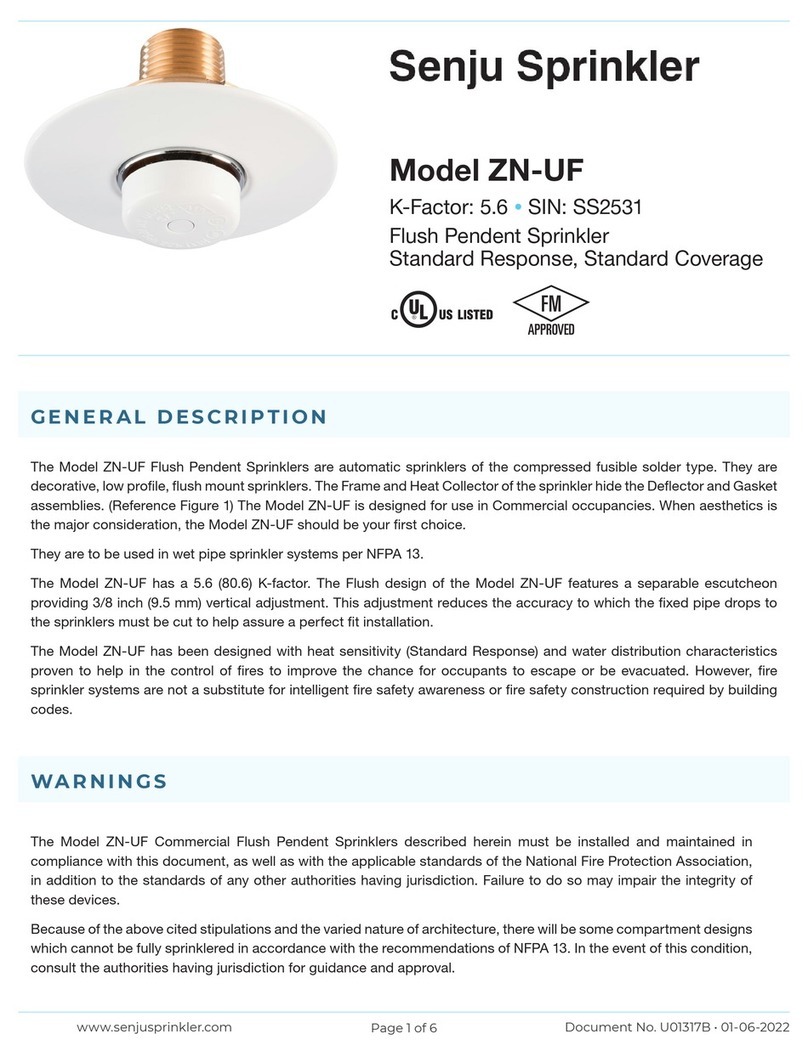
Senju Sprinkler
Senju Sprinkler ZN-UF User manual
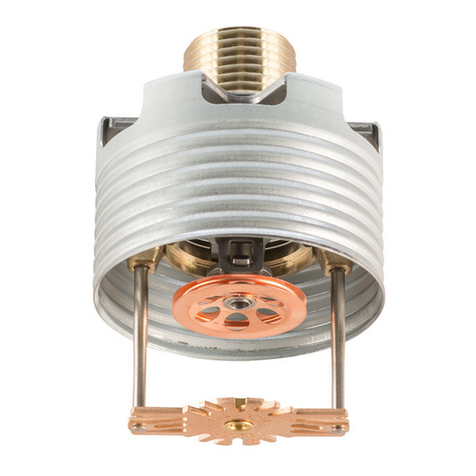
Senju Sprinkler
Senju Sprinkler RC-QR User manual
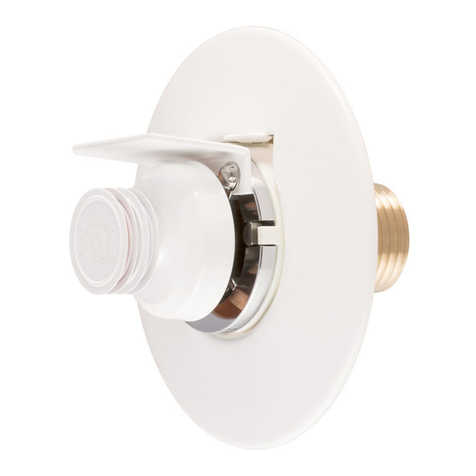
Senju Sprinkler
Senju Sprinkler HF-RES User manual
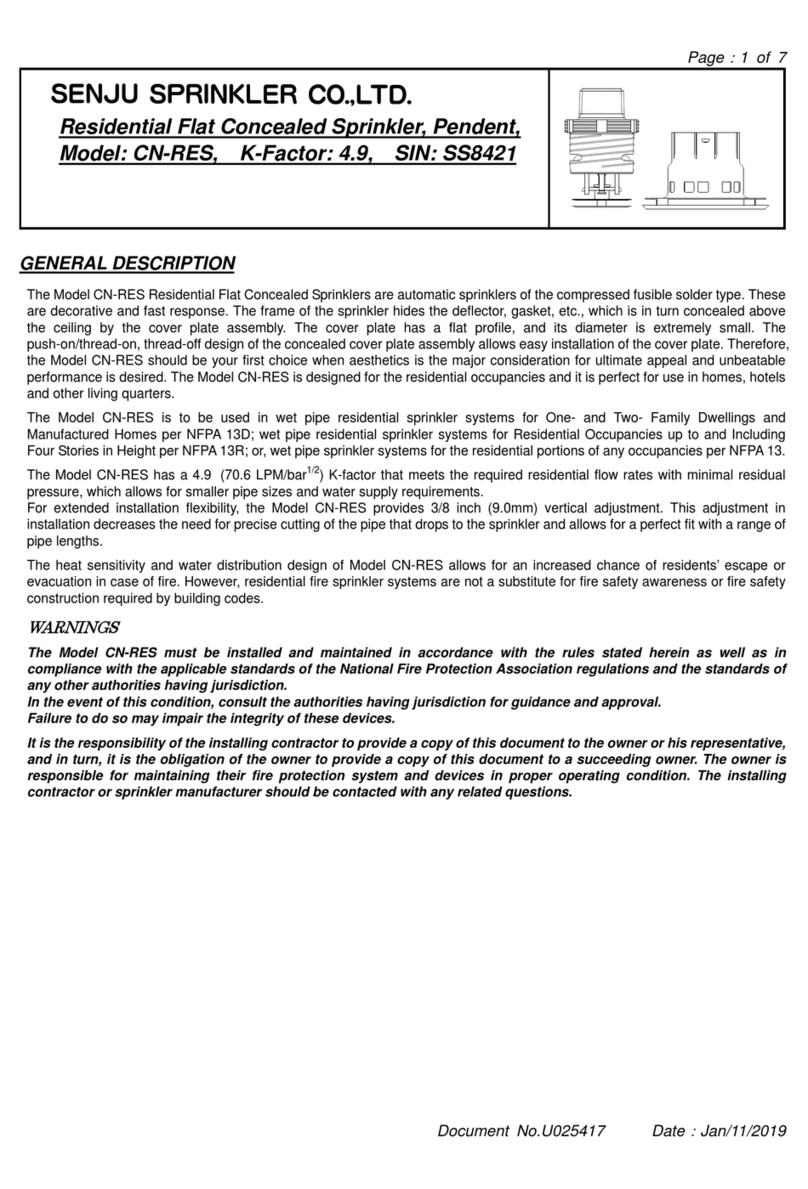
Senju Sprinkler
Senju Sprinkler CN-RES User manual
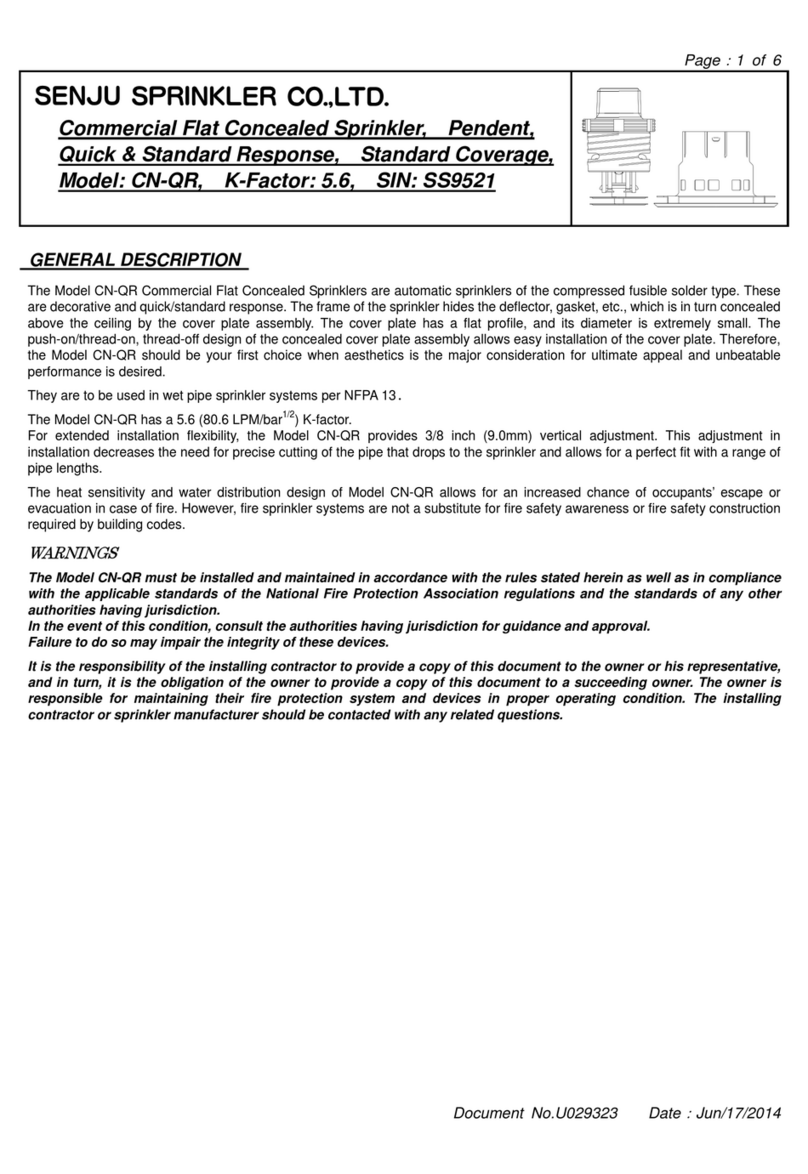
Senju Sprinkler
Senju Sprinkler CN-QR User manual
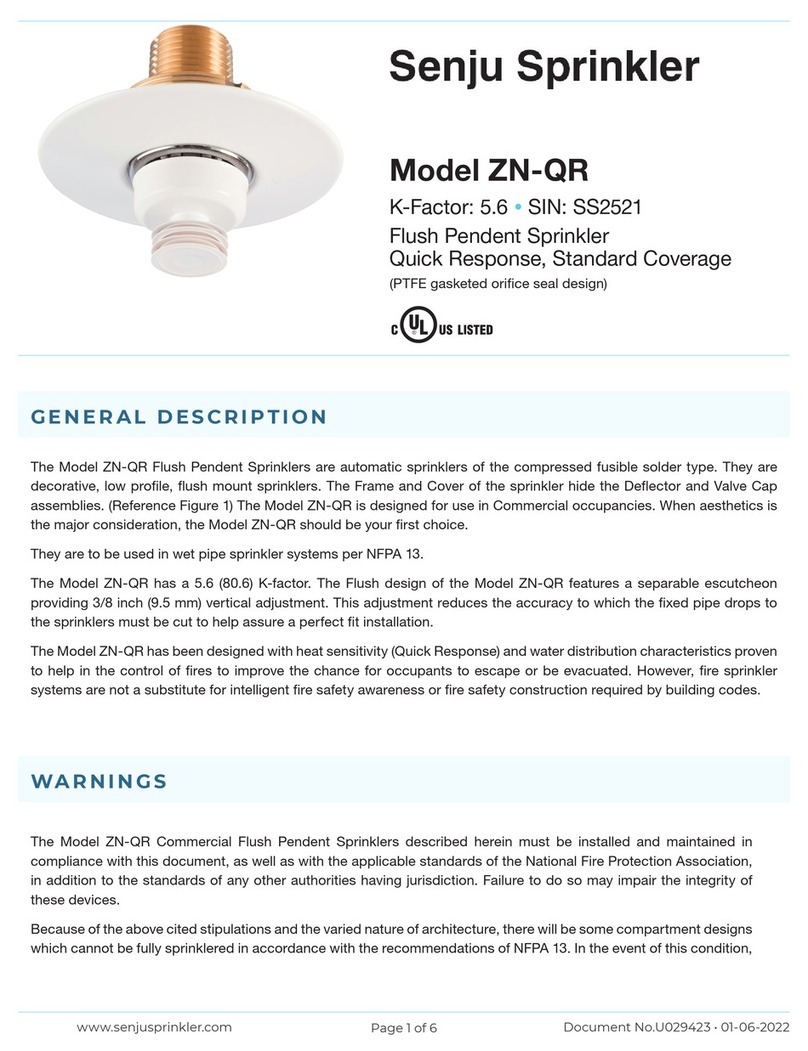
Senju Sprinkler
Senju Sprinkler ZN-QR User manual

Senju Sprinkler
Senju Sprinkler RC-QR-EC User manual
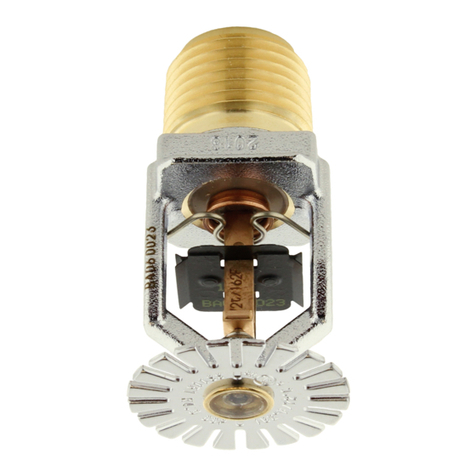
Senju Sprinkler
Senju Sprinkler FR-RES User manual

Senju Sprinkler
Senju Sprinkler RC-RES User manual
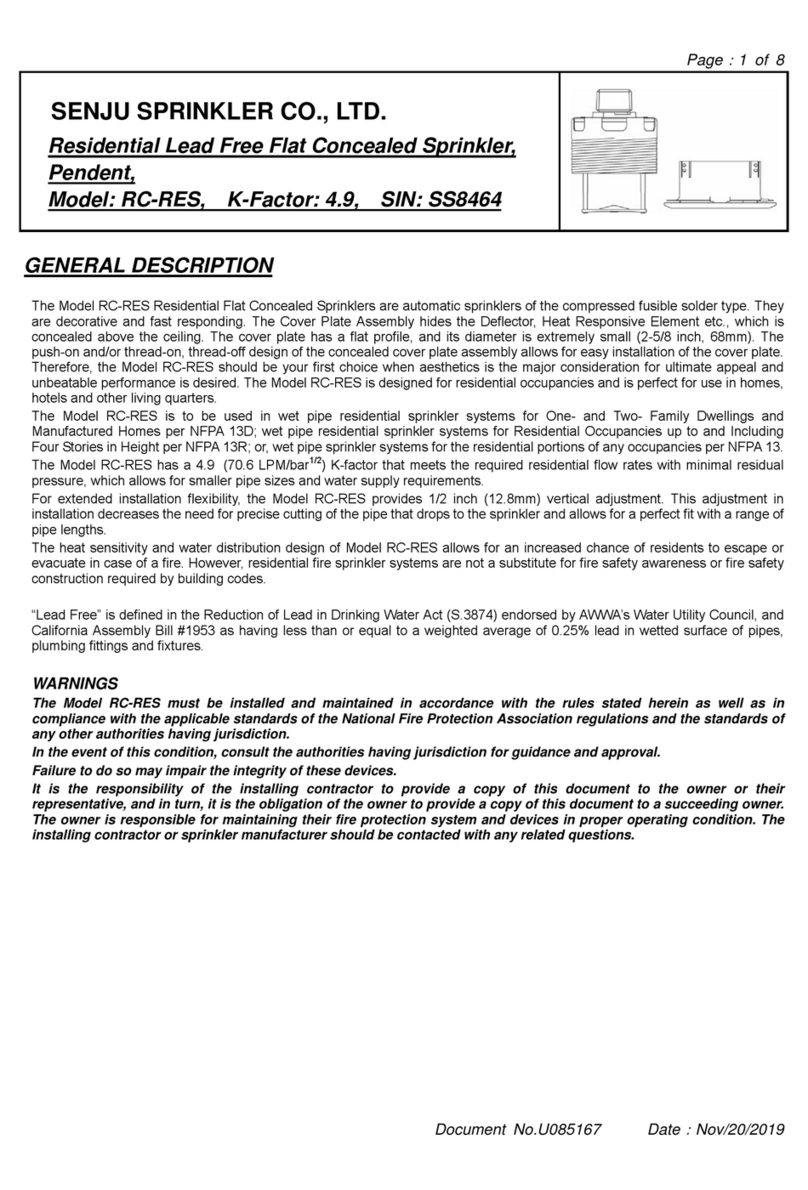
Senju Sprinkler
Senju Sprinkler SS8464 User manual




